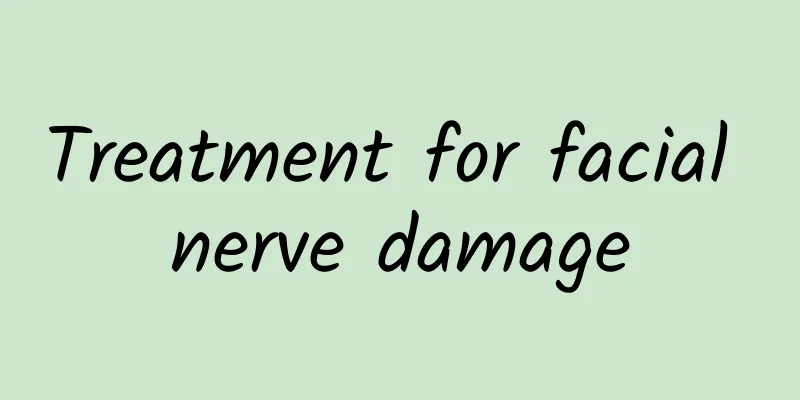Treatment for facial nerve damage

|
As we all know, the nervous system is the supreme commander of our body. It controls our life activities. If the nerves that send commands to a certain part are damaged, that part will lose its function. For example, if the facial nerves are damaged, various facial movements cannot be completed, which may cause facial paralysis. Treatment of facial nerve injury: Since the possibility of recovery after facial nerve injury is relatively high, early treatment should be based on non-surgical treatment, using dexamethasone and appropriate dehydration to reduce traumatic reaction and local edema, giving neurotrophic drugs and Calcium blockers can improve nerve metabolism and vascular blood supply, and often promote the recovery of nerve function. Surgical treatment is only used for patients whose nerves have been severed or whose severe facial paralysis has not responded to 4 to 6 months of non-surgical treatment. Its purpose is not only to restore the motor function of the facial muscles, but also to correct the appearance and relieve the psychological pressure of patients. There have been successful reports of intracranial reconstruction of facial nerve accidentally injured during surgery; however, there are no reports of reconstruction of traumatic facial paralysis. Early facial nerve canal decompression surgery not only has poor results, but may also aggravate nerve damage, so it should be performed with caution. In otorhinolaryngology, for injuries near the knee of the facial nerve, the facial nerve is often explored early through the middle ear or mastoid approach, and anastomosis is performed if severance is found. If it is compressive ischemia, decompression surgery is performed and the connective tissue sheath of the epineurium is opened. In neurosurgery, alternative repair surgery is often used for persistent complete facial paralysis, such as facial-cochlear nerve anastomosis or facial-phrenic nerve anastomosis. In addition, the facial-hypoglossal nerve anastomosis is rarely used nowadays because it will cause atrophy of the tongue muscles on one side, affecting speech and chewing after using the hypoglossal nerve to repair the facial nerve. 1. Facial-accessory nerve anastomosis This surgery involves end-to-end anastomosis of the central segment of the accessory nerve with the peripheral segment of the facial nerve. The surgical method is simple and has a high success rate. Most patients will have restored facial muscle movement 3 to 5 months after the operation. The disadvantage is that the sternocleidomastoid muscle and trapezius muscle innervated by the original accessory nerve will become paralyzed and atrophied, resulting in drooping shoulders. However, if the sternocleidomastoid branch of the accessory nerve is used and the trapezoidal branch is retained, scapulohumeral obstruction can be avoided; or the descending branch of the hypoglossal nerve is anastomosed with the surrounding segment of the accessory nerve to reduce the disadvantages of scapulohumeral obstruction. Patients with facial nerve damage are generally psychologically inferior, so it is recommended that patients build confidence, face the disease positively, accept the doctor's treatment suggestions, and strive for a speedy recovery. The face is the main criterion for people's first impression, so everyone should pay attention to protecting their face. In addition to nerve atrophy caused by the disease, most nerve damage is related to external pressure. |
<<: What to do if the lingual nerve is injured
>>: Treatment for vagus nerve damage
Recommend
What is the difference between eczema and urticaria? It mainly depends on the shape
There is a big difference between eczema and urti...
What are the effects of moxibustion in treating cysts?
Cysts are relatively common in clinical practice....
How to make Anshen Soup? There are 6 types
In recent years, with the increasing pressure of ...
Pros and cons of orthodontics
As people's living standards improve, they pa...
Kidney function tests
The kidneys are important organs in the human bod...
How to cleanse your stomach and intestines
In our daily life, we eat a lot of things every d...
What medicine can quickly relieve itching of the vulva
The vulva can be said to be a relatively private ...
The efficacy and function of yellow peel parasite
The yellow-bark tree likes a damp and cool natura...
Coughing and a little breathless, what should I do?
In daily life, cough is a common cold symptom. Es...
Symptoms of tricuspid regurgitation
The tricuspid valve can be simply understood as a...
Rubella vaccine precautions
Rubella is a very common infectious disease. The ...
Shave this part of your body regularly to keep away diseases all year round!
Nowadays, many people in society choose scraping....
What is abnormal erection?
Abnormal erection refers to the phenomenon that a...
What are the precautions for acupoint massage
Massage, especially acupoint massage, has great b...
Can taking vitamin E remove freckles?
Facial spots are quite annoying. There are many r...









